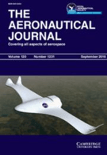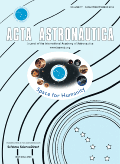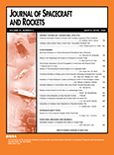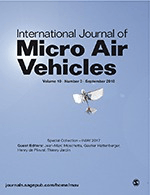
Journal of the Korean Society for Aeronautical and Space Sciences
Scope & Guideline
Exploring New Frontiers in Aerospace Engineering
Introduction
Aims and Scopes
- Aerodynamics and Fluid Mechanics:
The journal publishes research on the behavior of air and other fluids in motion, particularly as they relate to aircraft and spacecraft design and performance. - Flight Dynamics and Control Systems:
Research in this area emphasizes the analysis and design of flight control systems, including algorithms for autopilot systems and UAV control. - Propulsion Systems and Combustion:
Papers focus on the development and analysis of propulsion systems, including liquid and hybrid rocket engines, and combustion phenomena. - Structural Analysis and Material Science:
This scope includes studies on the structural integrity of aerospace components, material properties, and innovations in composite materials. - Unmanned Aerial Vehicles (UAVs) and Drones:
Research dedicated to UAV technology, including design, operation, and applications in various fields such as surveillance, agriculture, and urban mobility. - Space Systems and Satellite Technology:
The journal covers advancements in satellite design, launch systems, and space mission analysis, particularly focusing on small satellites and CubeSats. - Artificial Intelligence and Machine Learning Applications:
Research employing AI and machine learning techniques to optimize various aerospace processes, including design, control, and predictive maintenance.
Trending and Emerging
- Artificial Intelligence in Aerospace:
There is a growing trend in applying AI and machine learning for optimizing designs, enhancing autonomous flight capabilities, and improving diagnostic systems in aerospace applications. - Sustainable and Green Propulsion Systems:
Research focusing on environmentally friendly propulsion systems, including green propellants and electric propulsion methods, has gained significant traction in recent years. - Urban Air Mobility (UAM) and eVTOL Technologies:
The exploration of urban air mobility solutions and electric vertical takeoff and landing (eVTOL) aircraft is emerging as a critical area of research, addressing future transportation needs. - Advanced Computational Methods:
The use of advanced computational techniques such as CFD, numerical simulations, and optimization algorithms is increasingly common, reflecting the need for precision in aerospace engineering. - Robotics and Autonomous Systems:
Research in robotics, particularly in relation to UAVs and space exploration, is on the rise, with a focus on autonomy, swarm technologies, and cooperative systems.
Declining or Waning
- Traditional Aeronautical Engineering:
Research related to conventional aeronautical engineering methods, such as basic aerodynamic analysis without modern computational techniques, appears to be less prominent. - Basic Propulsion Theory:
The focus on fundamental propulsion theories and classical rocket science has waned, likely due to the shift towards more applied and innovative propulsion technologies. - Static Structural Analysis:
While structural analysis remains important, there is a noticeable decrease in papers focusing solely on static analysis as more dynamic and complex methodologies are being adopted. - Static Wind Tunnel Testing:
Research utilizing traditional wind tunnel testing methods has decreased, as computational fluid dynamics (CFD) and other simulation techniques are increasingly preferred. - Conventional UAV Applications:
Studies on basic UAV applications without advanced functionalities or integrations have seen a decline, reflecting a trend towards more sophisticated UAV systems.
Similar Journals

Unmanned Systems
Elevating Research in Aerospace and Automotive AutomationUnmanned Systems is a leading academic journal published by WORLD SCIENTIFIC PUBL CO PTE LTD based in Singapore, that serves as a premier platform for research and advancements in unmanned vehicle technology. Covering a broad range of disciplines, the journal ranks in the Q1 category for Aerospace Engineering, Automotive Engineering, Control and Optimization, and Control and Systems Engineering as of 2023, showcasing its high impact within these fields. With impressive Scopus rankings placing it in the top tiers of its categories—8th in Control and Optimization and 14th in Aerospace Engineering—Unmanned Systems stands out as a vital resource for researchers, professionals, and students eager to explore current trends and innovations. While the journal operates under a traditional access model, it remains committed to disseminating quality original research, reviews, and case studies that contribute significantly to the understanding and application of unmanned technologies from 2013 through 2024.

Journal of Aerospace Technology and Management
Elevating Aerospace Innovation and Management.The Journal of Aerospace Technology and Management, published by the Instituto de Aeronáutica e Espaço (IAE), serves as a pivotal platform for the dissemination of innovative research in the fields of Aerospace Engineering and Computational Mechanics since its inception in 2009. With an ISSN of 1984-9648 and an E-ISSN of 2175-9146, this Open Access journal facilitates unrestricted access to quality research, fostering knowledge sharing and collaboration among researchers, professionals, and academic institutions worldwide. Based in Brazil, it ranks in the Q3 category according to the latest metrics (2023), highlighting its growing influence and relevance in the competitive landscape of aerospace studies. The journal currently boasts notable Scopus rankings, ensuring that published works achieve widespread recognition and impact within the scientific community. Its diverse scope encompasses a blend of theoretical and applied research, making it an indispensable resource for those seeking to explore groundbreaking advancements in aerospace technologies and management.

AERONAUTICAL JOURNAL
Exploring the frontiers of flight and technology.Aeronautical Journal, published by Cambridge University Press, is a premier scholarly journal dedicated to advancing the field of aerospace engineering. With a notable impact factor, this journal holds a strong position in the academic community, ranked #53 out of 153 in the Scopus category of Aerospace Engineering, placing it in the 65th percentile. The journal has been providing a platform for groundbreaking research since its inception in 1969, and continues to be a vital resource for researchers, professionals, and students involved in aeronautics. As a Q2 journal in the 2023 Aerospace Engineering category, it offers high-quality articles that cover a range of topics within the discipline, contributing to the ongoing discourse and innovation in aerospace technologies. Although not an open-access journal, it remains accessible to a vast readership through institutional subscriptions and partnerships. The Aeronautical Journal is a crucial publication for those seeking to stay at the forefront of aerospace research and development.

ACTA ASTRONAUTICA
Inspiring Innovation in Aerospace EngineeringACTA ASTRONAUTICA is a premier journal in the field of aerospace engineering, dedicated to advancing knowledge in space exploration and technology. Published by PERGAMON-ELSEVIER SCIENCE LTD in the United Kingdom, this journal boasts a prestigious Q1 ranking within its category as of 2023, positioning it in the top tier of aerospace engineering publications. With an ISSN of 0094-5765 and an E-ISSN of 1879-2030, ACTA ASTRONAUTICA has been a crucial resource for researchers and professionals since its inception in 1974, continuing to publish cutting-edge research through to 2024. The journal focuses on a wide range of topics, from orbital mechanics and spacecraft design to astronautics and planetary science, aiming to inspire innovation and facilitate the exchange of ideas among scholars, industry experts, and students. ACTA ASTRONAUTICA is ranked 19th out of 153 in its field, highlighting its importance and influence within the aerospace community. Researchers seeking a reputable platform to share their findings will find this journal to be an essential part of the academic discourse in aerospace engineering.

JOURNAL OF THE ASTRONAUTICAL SCIENCES
Exploring the Frontiers of Aerospace InnovationJOURNAL OF THE ASTRONAUTICAL SCIENCES, published by Springer Heidelberg, serves as a leading platform dedicated to advancing the fields of aerospace engineering and planetary science. With an ISSN of 0021-9142 and an E-ISSN of 2195-0571, this journal has established a significant presence within the academic community, evidenced by its categorization in the Q2 and Q3 quartiles for 2023, positioning it among the top publications in its field. The journal encompasses a spectrum of research that spans from innovative aerospace technologies to the exploration of planetary systems, reflecting its rich scope developed since its inception in 1969. Although not Open Access, it provides vital contributions to ongoing discussions in aerospace research, appealing to researchers, professionals, and students eager to deepen their understanding of astronautics. With a notable impact factor and rankings in Scopus—66th in Aerospace Engineering and 64th in Space and Planetary Science—this journal continues to be a pivotal resource for those engaged in the exploration and utilization of space.

Aerospace
Inspiring the Next Generation of Aerospace InnovatorsAerospace is a premier open-access journal published by MDPI, established in 2014 and dedicated to the dynamic field of aerospace engineering. With an impressive Q2 ranking in the 2023 category of Aerospace Engineering, this journal is a vital resource for researchers, professionals, and students interested in advancements and innovations in aerodynamics, avionics, propulsion, and more. Operating from Switzerland, Aerospace provides a platform for the dissemination of high-quality research articles and reviews, contributing to the ongoing dialogue in the aerospace community. This journal not only enhances visibility through its open access model but also ensures that critical knowledge is freely available, fostering collaborative efforts and inspiring the next generation of aerospace engineers. With a Scopus ranking of #60 out of 153 in the Aerospace Engineering category, it plays a significant role in shaping the future of aviation and space exploration.

JOURNAL OF SPACECRAFT AND ROCKETS
Connecting Researchers to the Cosmos.The Journal of Spacecraft and Rockets, published by the American Institute of Aeronautics and Astronautics, serves as a premier platform for disseminating cutting-edge research in the fields of aerospace engineering and space science. Established in 1964, this esteemed journal has evolved over nearly six decades, solidifying its reputation with a consistent publication history through 2024. With an impact factor positioning it within the Q2 quartile in both Aerospace Engineering and Space and Planetary Science categories, it ranks as a vital resource, featuring high-quality manuscripts that address the latest advancements and findings in spacecraft design, propulsion systems, and austere planetary exploration. The journal's rigorous peer-review process ensures that articles meet the high academic standards expected by practitioners in the aerospace sector. Researchers, engineers, and students alike will find the Journal of Spacecraft and Rockets to be an invaluable resource for both foundational knowledge and innovative research developments, advancing the future of aeronautics and astronautics.

Journal of Aerospace Information Systems
Exploring New Frontiers in Aerospace EngineeringJournal of Aerospace Information Systems, published by the American Institute of Aeronautics and Astronautics, is a premier scholarly platform dedicated to advancing the interdisciplinary field of aerospace information systems. With a focus on innovative research and practical applications, this journal supports the dynamic integration of aerospace engineering, computer science, and electrical engineering. Positioned in Q2 quartiles for 2023 in its respective categories, it ranks notably in Aerospace Engineering (#52/153) and Electrical and Electronic Engineering (#357/797), indicating its significant influence within the scientific community. Research published within its pages addresses a diverse range of technological advancements and applications that are vital for the development of contemporary aerospace systems. As an open-access journal, it facilitates broader dissemination of knowledge, allowing researchers, professionals, and students to engage with cutting-edge discoveries and methodologies. With its competitive impact and commitment to fostering innovation, the Journal of Aerospace Information Systems is an essential resource for anyone involved in the burgeoning field of aerospace technology.

International Journal of Micro Air Vehicles
Connecting Scholars and Professionals in MAV TechnologyThe International Journal of Micro Air Vehicles, published by SAGE Publications Ltd, stands as a pioneering platform for cutting-edge research in the rapidly evolving field of micro air vehicle (MAV) technology. With an ISSN of 1756-8293 and an E-ISSN of 1756-8307, this journal caters to a diverse readership, including aerospace engineers, researchers, and industry professionals who are at the forefront of innovation in aerospace engineering. It holds a commendable position within the Q3 category of Aerospace Engineering for 2023 and is ranked 65th out of 153 in Scopus, placing it in the 57th percentile among its peers. As a vital resource since its inception in 2010, the journal emphasizes advancements in design, performance, and applications of MAVs, while facilitating knowledge sharing and collaboration across disciplines. Although it operates on a subscription model, the journal ensures accessibility of pivotal research findings for professionals and scholars alike, aiming to shape the future of aerospace applications through rigorous academic inquiry.

JOURNAL OF THE AMERICAN HELICOPTER SOCIETY
Connecting Research and Practice in Helicopter Technology.The Journal of the American Helicopter Society, published by the American Helicopter Society Inc., serves as a leading platform for innovative research in aerospace engineering, mechanical engineering, and materials science. With its ISSN 0002-8711 and E-ISSN 2161-6027, this esteemed journal has been disseminating pivotal findings since 1969 and continues to capture cutting-edge advancements in the field. The journal is distinguished by its position in the top quartile (Q1) for Aerospace Engineering and Mechanics of Materials, and Q2 for Materials Science (miscellaneous), reflecting its rigorous standards and significant influence on both academia and industry. Researchers, professionals, and students benefit from access to comprehensive studies, case analyses, and reviews, all aimed at enhancing knowledge and fostering innovation in rotary-wing aircraft technologies. As the field continues to evolve through new challenges and innovations, the Journal of the American Helicopter Society remains a vital resource for those committed to advancing helicopter design, operation, and safety.